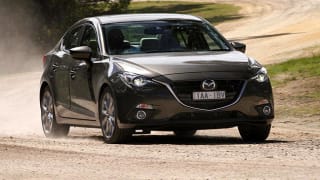
Mazda 3 2014 Review
Picture this. A deserted canyon road on the edges of the desert in California. A lone eagle wheels...
Browse over 9,000 car reviews
Here it is. The all-new singing and dancing Pulsar SSS, a name that set many a boy's heart racing a few years back. Most people will associate the name with the early 90s hatch with its defining high rise rear spoiler and bold, `monster' style SSS decals on the back.
The new SSS sheds the boy racer looks, cutting a much more conservative figure but Nissan would probably like to think it holds the same sort of appeal. Maybe, maybe not?
Priced from $29,240 for the manual and $31,740 for the auto, it remains an interesting proposition. The price buys you a 1.6-litre turbocharged engine with 140kW on tap, a body kit and 17 inch alloys - but you'd be forgiven for missing the understated kit that does little to lift the car's image.

It is perhaps appropriate at this point to mention the option of the cheaper ST-S model, with the same 1.6-litre turbocharged engine priced from $24,990 - minus the body kit and a some other bits and pieces.
At the same time we should all fall to our knees and thank the Nissan Gods for getting rid of the ugly, misshapen Tiida and for restoring the Pulsar name - we hate to say we told you so (but we did).
Standard equipment this time around includes leather, dual zone climate air, xenon head lights, six-speaker audio and a 5.8 inch touchscreen computer with satnav and a reversing camera - but why no LEDs?
The main selling point, the 1.6-litre direct injection, turbocharged four cylinder petrol engine is a detuned version of the unit that powers the Renault Clio Sport, with 140kW of power and and 240Nm of torque from 2000 revs, with a fuel consumption figure of 7.7 litres of fuel per 100km.
This compares with the standard 1.8-litre Pulsar's 96kW and 174Nm, but who really cares? The more interesting figures are those for the 1994 N14 SSS powered by a 2.0-litre twin cam that produced 105kW of power and 179Nm of torque, and used 7.0 litres/100km (the increase in consumption can be explained by the additional weight of the new model with its extra safety systems).
Several techniques have been used to reduce friction and make the engine smoother. These include a carbon coating for the valve lifters and mirror finish for the camshafts. Low tension piston rings with a hard ceramic chromium nitride coating are also used along with low friction engine oil. The turbo is paired with either the six-speed manual we tested or a CVT style auto with M or manual mode, the latter designed to optomise power versus economy.
The car is surprisingly roomy inside, with an impressive amount of rear legroom that does not appear to have been at the expense of luggage space. The cabin is trimmed to a high standard, with faux carbon fibre surround for the centre instrument console while the computer screen is smallish but functional, with support for bluetooth audio streaming. The boot looks tacky in contrast and hides a full size steel spare wheel.
It gets a full five stars for safety, with six airbags, electronic traction and stability control, anti-lock brakes, with brake assist and electronic brake force distribution.
Our manual test car is likely to be the first choice for enthusiasts and while it generally works well, it can be easy to lose track of gates when banging through the gears. Fortunately the turbo doesn't suffer from the same shocking throttle flair that marks the 1.8-litre manual. There's a tiny bit in evidence, but thankfully not enough to be a nuisance.
Driving the car for the first time, it's not the extra power but the significant increase in torque that is immediately apparent. There's a spring in its step in just about every gear and it can make it difficult to identify what gear you're in without reaching for the gear stick.
You can feel the car lift as the tacho approaches 3000 revs and the boost from the turbo kicks in. It's a bit awkward to get off the line cleanly, but offers strong mid-range response where you want it. Fitted with 205/50 17s the tyres look a bit skinny for the car, but do a good job of keeping it glued to the road. It felt flighty at first, but tucks into corners and rounds up nicely even when pushed hard.
It's no Golf GTI, but then it's not trying to be (and it's about 10 grand cheaper). The SSS is more of an in-betweenie, with a significant increase in performance but there's still plenty of room for improvement in the looks department - Tiida or no Tiida.
| Vehicle | Specs | Price* | |
|---|---|---|---|
| ST-L | 1.8L, —, 6 SP MAN | $6,930 – 9,790 | 2013 Nissan Pulsar 2013 ST-L Pricing and Specs |
| ST | 1.8L, —, CVT AUTO | $7,480 – 10,560 | 2013 Nissan Pulsar 2013 ST Pricing and Specs |
| ST-S | 1.6L, —, 6 SP MAN | $7,810 – 11,000 | 2013 Nissan Pulsar 2013 ST-S Pricing and Specs |
| ST | 1.8L, —, 6 SP MAN | $6,930 – 9,790 | 2013 Nissan Pulsar 2013 ST Pricing and Specs |
$3,800
Lowest price, based on 109 car listings in the last 6 months